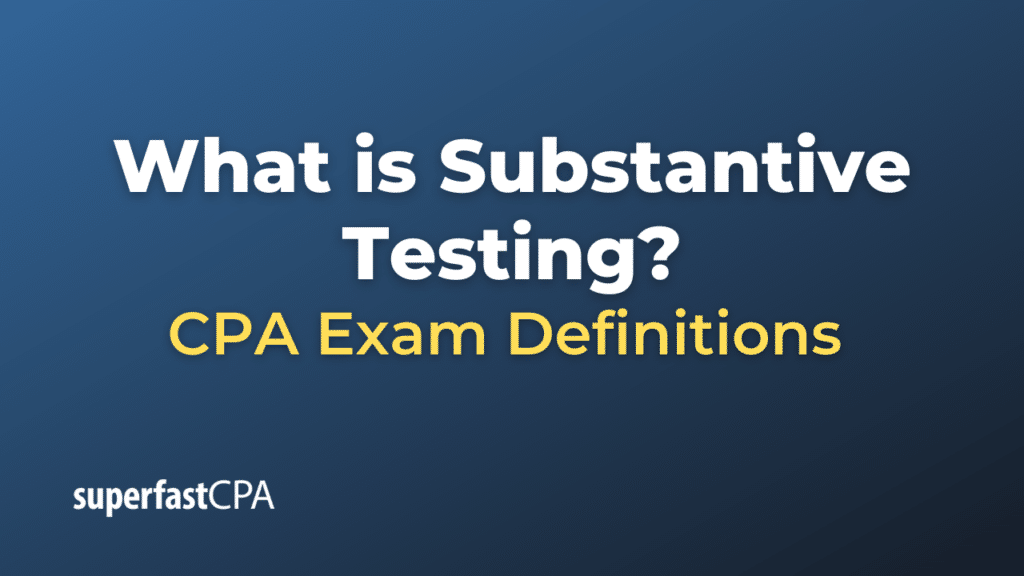Substantive Testing
Substantive testing, also known simply as substantive procedures, refers to the specific audit procedures designed to obtain evidence to determine whether financial statements are free of material misstatement. These tests directly examine the financial data, account balances, transactions, and disclosures.
The purpose of substantive testing is twofold:
- To detect material misstatements at the assertion level in the financial statements, allowing the auditor to form an opinion on the overall truth and fairness of the statements.
- To provide evidence that supports the numbers and details in the financial statements.
Substantive testing can be categorized into:
- Tests of Details:
- These tests focus on verifying the amounts and details of specific financial statement items. Examples include:
- Vouching a sample of sales transactions to supporting documents, such as sales invoices and delivery notes.
- Confirming account balances with third parties (e.g., bank balances with bank statements or accounts receivable with customers).
- Physically inspecting assets, like property or equipment, and comparing their condition and value to what’s reported in the financial statements.
- These tests focus on verifying the amounts and details of specific financial statement items. Examples include:
- Substantive Analytical Procedures:
- These involve comparisons and evaluations of financial information, and the relationships between both financial and non-financial data. Examples include:
- Comparing the current year’s financial ratios to prior years, budgets, or industry averages.
- Evaluating the reasonableness of certain account balances based on the auditor’s understanding of the client and the industry it operates in.
- Investigating significant variances or unexpected relationships identified during these comparisons.
- These involve comparisons and evaluations of financial information, and the relationships between both financial and non-financial data. Examples include:
The extent and nature of substantive tests depend on the auditor’s risk assessment, the effectiveness of the entity’s internal controls, and the specific accounts or assertions being tested. If controls are strong and tests of controls provide sufficient evidence, the extent of substantive testing might be reduced. Conversely, if controls are weak or non-existent, auditors will place greater reliance on substantive tests to form their opinion.
Example of Substantive Testing
Let’s delve into a practical example of substantive testing applied to the accounts receivable of a fictional company:
Company: StarTech Solutions
Scenario: StarTech Solutions is a software company that provides enterprise solutions to other businesses. Over the past year, the company has expanded its customer base rapidly, leading to a significant increase in its accounts receivable balance.
Objective: As an auditor, you want to ensure that the accounts receivable balance stated on the balance sheet is accurate, existent, and collectible.
Substantive Tests:
- Confirmation of Balances:
- Send out confirmation letters to a sample of StarTech’s customers, asking them to confirm the amounts they owe to StarTech directly to you, the auditor.
- Aging Analysis:
- Review the aging report of accounts receivable to identify any long-outstanding amounts.
- For any amounts that have been due for an extended period (e.g., over 90 days), inquire with StarTech’s management about the likelihood of collection and any provisions for doubtful accounts.
- Review of Subsequent Collections:
- Examine cash receipts after the balance sheet date but before the audit report date. Determine if the receivables at year-end have since been collected.
- Examination of Supporting Documents:
- Select a sample of accounts receivable transactions from the ledger.
- Vouch these to supporting documentation, such as invoices, contracts, and delivery receipts, to ensure they are valid and accurate.
- Substantive Analytical Procedures:
- Compare the current year’s ratio of accounts receivable to sales with the prior year. A significant increase might indicate slower collection or issues with credit sales‘ validity.
- Review the bad debt expense as a percentage of sales. If there’s a dramatic change from the prior year without a clear reason, further investigation might be necessary.
By performing these substantive tests, the auditor can gather sufficient evidence about the existence, accuracy, valuation, and rights and obligations associated with StarTech Solutions’ accounts receivable. If anomalies or discrepancies are identified, they’ll need further investigation, and potential adjustments might be required in the financial statements.













